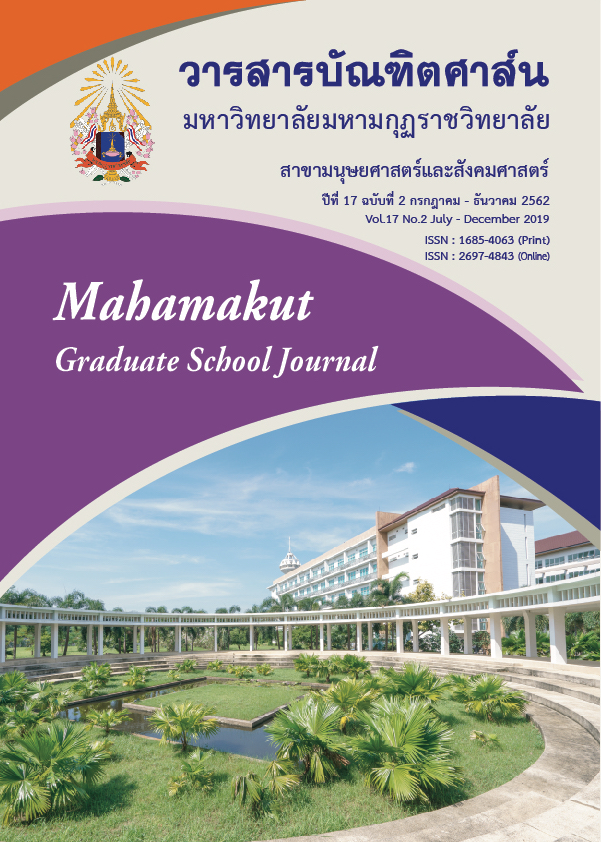รูปแบบการบริหารจัดการที่ส่งผลต่อความสำเร็จของสถานตรวจสภาพรถเอกชน (ตรอ.) ในประเทศไทย
คำสำคัญ:
ปัจจัยทีมีอิทธิพลต่อความสำเร็จ ตรวจสภาพรถบทคัดย่อ
การวิจัยครั้งนี้มีวัตถุประสงค์เพื่อ (1) เพื่อวิเคราะห์หาความสัมพันธ์เชิงสาเหตุที่เกี่ยวข้องระหว่างคุณลักษณะผู้นำ การบริหารจัดการ และ ความพึงพอใจของลูกค้า ที่ส่งผลต่อความสำเร็จของสถานตรวจสภาพรถเอกชนในประเทศไทย และ (2) เพื่อกำหนดรูปแบบการบริหารจัดการที่ส่งผลต่อความสำเร็จของสถานตรวจสภาพรถเอกชนในประเทศไทย การวิจัยครั้งนี้เป็นการวิจัยแบบผสมผสาน (Mixed Methods Research) ที่ใช้ทั้งการวิจัยเชิงปริมาณ(Quantitative Research) และการวิจัยเชิงคุณภาพ (Qualitative Research) กลุ่มตัวอย่างที่ใช้ในการวิจัยเชิงปริมาณ เป็นผู้ประกอบการหรือผู้จัดการหรือตัวแทน สถานตรวจสภาพรถเอกชน จำนวน 335 คน ได้มาจากการสุ่มอย่างง่าย จากจำนวนประชากรทั้งสิ้น 2,034 ราย ทั่วประเทศ และกลุ่มตัวอย่างที่ใช้ในการวิจัยเชิงคุณภาพคือผู้เชี่ยวชาญหรือผู้บริหารระดับสูงในสถานตรวจสภาพรถเอกชนตำแหน่งผู้ประกอบการหรือผู้จัดการหรือตัวแทนจำนวนทั้งสิ้น 19 ราย เครื่องมือที่ใช้ในการวิจัยประกอบด้วยแบบสอบถาม และแบบสัมภาษณ์แบบมีโครงสร้าง สถิติที่ใช้ในการวิเคราะห์ข้อมูล ได้แก่ ความถี่ ร้อยละ ค่าเฉลี่ย ส่วนเบี่ยงเบนมาตรฐาน และ การวิเคราะห์สมการเชิงโครงสร้าง ด้วยโปรแกรมสำเร็จรูปทางสถิติ
ผลการวิจัยพบว่าความสัมพันธ์เชิงสาเหตุของปัจจัยที่มีอิทธิพลทางตรงต่อความสำเร็จของสถานตรวจสภาพรถเอกชน ประกอบด้วย คุณลักษณะของผู้นำ มีอิทธิพลสูงสุด (β=0.536) รองลงมาคือ การบริหารจัดการภายในองค์การ (β=0.381) และความพึงพอใจของลูกค้า (β=0.291) และรูปแบบการบริหารจัดการที่ส่งผลต่อความสำเร็จของสถานตรวจสภาพรถเอกชนในประเทศไทยพบว่าโมเดลความสอดคล้องกลมกลืนกับข้อมูลเชิงประจักษ์อยู่ในเกณฑ์ดี ณ ระดับนัยสำคัญทางสถิติ 0.05 กล่าวคือค่า Chi-square = 31.812, df=21, chi-square/df =1.515, P-value=0.061, RMR=0.028, TLI=0.988, CFI=0.993, RMSEA=0.039, HOELTER (0.05) =344 ผ่านเกณฑ์มาตรฐานทุกค่า
เอกสารอ้างอิง
ขวัญใจ สุดรัก. (2553). ปัจจัยการบริหารที่ส่งผลต่อประสิทธิผลการดำเนินงานตามมาตรฐานศูนย์เลี้ยงดูเด็กก่อนวัยเรียนเอกชน.วิทยานิพนธ์ คณะศึกษาศาสตรมหาบัณฑิต(เทคโนโลยีการศึกษา). มหาวิทยาลัยเทคโนโลยีราชมงคลธัญบุรี.
จุฬาลักษณ์ ณีรัตนพันธุ์.(2540). กลยุทธ์การบริหารการพยาบาล,ขอนแก่น: คณะพยาบาลศาสตร์ มหาวิทยาลัยขอนแก่น,54.
ทองหล่อ เดชไทย. (2544). ภาวะผู้นำ: เพื่อการบริหารคุณภาพสู่ความเป็นเลิศ = Leadership for excellent quality management. กรุงเทพฯ : ภาควิชาบริหารงานสาธารณสุข คณะสาธารณสุขศาสตร์ มหาวิทยาลัยมหิดล.
ประเวศ วะสี. (2540). ภาวะผู้นำกับพยาธิสภาพในสังคมไทยและวิธีการแก้ไข ในสงวน นิตยารัมพงศ์ และสิทิลักษณ์ สมิตะสิริ(บรรณาธิการ).ภาวะผู้นำ ความสำคัญต่ออนาคตไทย, กรุงเทพฯ: พิมพ์ไทย, 53-74.
พระธรรมปิฎก (ป.อ.ปยุโต). (2540). ภาวะผู้นำ. ในสงวน นิตยารัมพงศ์ และสิทิลักษณ์ สมิตะสิริ(บรรณาธิการ).ภาวะผู้นำ ความสำคัญต่ออนาคตไทย, กรุงเทพฯ: พิมพ์ไทย, 18-19.
เพ็ญศรี ชุนใช้.(2540). ความเป็นผู้นำ: แนวคิดสำหรับพยาบาลและผู้บริหารการพยาบาล, ขอนแก่น ภาควิชาการศึกษาวิจัย และบริหารการพยาบาล คณะพยาบาลศาสตร์ มหาวิทยาลัยขอนแก่น 38.
รังสรรค์ ประเสริฐศรี. (2548).พฤติกรรมองค์การ, กรุงเทพฯ: ธรรมสารการพิมพ์, 31.
สุขคะเสริม สิทธิเดช และ ธร สุนทรายุทธ. (2556). ปัจจัยที่ส่งผลต่อการบริหารจัดการงานวิชาการในโรงเรียนมัธยมศึกษา.วารสารการศึกษาและการพัฒนาสังคม ปีที่ 9 ฉบับที่ 1 ปีการศึกษา 2556 สังกัดแผนกศึกษาธิการแขวงคำ ม่วน สาธารณรัฐประชาธิปไตยประชาชนลาว
สุภมาส อังศุโชติ, สมถวิล วิจิตวรรณา และรัชนีกูล ภิญโญภานุวัฒน์. (2557). สถิติวิเคราะห์สำหรับการวิจัยทางสังคมศาสตร์และพฤติกรรมการศาสตร์ เทคนิคการใช้โปรแกรม Lisrel. พิมพ์ครั้งที่ 4. กรุงเทพฯ : เจริญดีมั่นคงการพิมพ์.
อานันท์ ปันยารชุน. (2540). ผู้นำคือคนที่คนอื่นอยากเดินตาม. ใน สงวน นิตยารัมพงศ์ และ สิทิลักษณ์ สมิตะสิริ(บรรณาธิการ).ภาวะผู้นำ ความสำคัญต่ออนาคตไทย, กรุงเทพฯ: พิมพ์ไทย, 37-39.
Andrew J. Dubrin.(1998). Leadership Research Findings, Practice, and Skills(Houghton Miffin Company),2.
Barney J.(2004). Introduction: William Ouchi's Theory Z: How American business can meet the Japanese Challenge; Journal Article published Nov 2004 in Academy of Management Perspectives volume 18 issue 4 on pages 106 to 107
Brech, E., Thomson, A., & Wilson, J. F. (2010). Urwick Orr and Partners. Lyndall Urwick, Management Pioneer, 91–116. doi:10.1093/acprof:oso/9780199541966.003.0006
B.M. Bass. (1981). Stogdill’s handbook of leadership: A survey of theory and research. New York: The Free Press, 14.
Cleland, D.I. (1986). Measuring Success: The owner’s viewpoint. Proceedings of the 18th Annual Seminar/Symposium (Montreal/Canada), 6-12. Upper Darby, PA: Project Management Institute.
ดาวน์โหลด
เผยแพร่แล้ว
รูปแบบการอ้างอิง
ฉบับ
ประเภทบทความ
สัญญาอนุญาต
บทความวิชาการและบทความวิจัยในวารสารฉบับนี้ถือเป็นความรับผิดชอบของผู้เขียนเท่านั้น บทความที่ได้รับการตีพิมพ์ในวารสารบัณฑิตศาส์น ถือเป็นลิขสิทธิ์ของมหาวิทยาลัยมหามกุฏราชวิทยาลัย ตามพระราชบัญญัติลิขสิทธิ์



